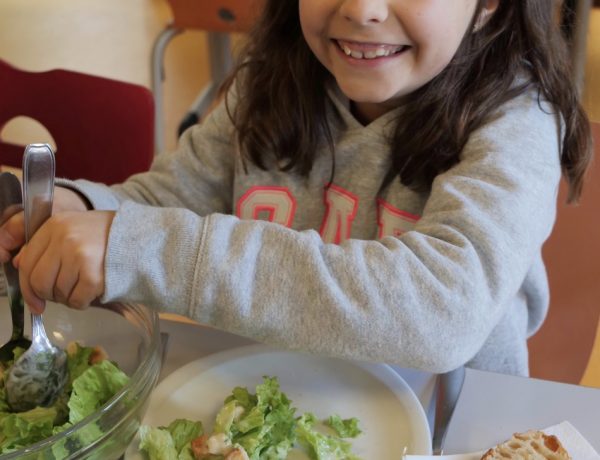The French take their food seriously. But they also want to eliminate food waste in school cafeterias! Two thirds of elementary school-aged children in France (7 million kids) eat the school cafeteria lunch at least once a week (a fixed menu meal served at the school). According to the French Agency for Ecological Transition (ADEME), out of each school lunch, 110 grams (3.9 ounces) of food is thrown out. Every year, the country’s public restaurants waste more than 3.8 billion meals in France. These include school cafeterias, hospitals, nursing homes and others.
To eliminate food waste in school cafeterias, France passed a law in 2016 that requires food waste in the schools to decrease 50% by 2025 (relative to 2015 figures). Moreover, in 2021, a law which aims to fight against the negative effects of climate change, includes a mandate to public restaurants to find creative solutions to combat food waste over the next three years.
So how precisely will the French eliminate food waste in school cafeterias? Here are several concrete measures France has put in place to achieve its objective.
Adjust supply and demand
Know how many children will be eating before making meals
The key to limiting food waste is first and foremost knowing how many meals to make on the actual day. In school cafeterias, kids are often registered for school lunches on an annual or quarterly basis. So when students are sick or absent, the actual number of meals can often be erroneous. Thus, it’s crucial to ask parents to let the school know as early as possible when students will be absent. Schools can then set up an efficient system for communication with parents.
Adjust food quantity to the age of the kids
To prevent waste, French school cafeterias have committed to serving quantities of food that are adapted to the age of the child. For example, studies have shown that for children between 6-11 years old, the average amount of food they eat is approximately 300 grams (10.6 ounces). For each category of food, the French have also pulled statistics about how much children eat depending on their age.
Respect the children’s taste
French children eat everything because they have been trained from the first time they ate solids. Parents present new foods to babies and toddlers consistently in an effort to widen their palate. However, for school cafeterias there is a balance between wanting to offer a vast variety of food to children (one of their objectives), and offering choices that they will actually enjoy and eat (and not waste). French regulations require serving children, at minimum, a rotating menu of 20 meals. This is why eating chicken nuggets or pizza every day is not possible in French school cafeterias. So children will never see the same meal in a one-month period.
In elementary schools, lunchroom supervisors encourage students to try a bit of everything. So how to make sure that, when children are less enthused by the lunch menu on a certain day, they eat their lunch without wasting food? The solution in France is to ask the child how much they are willing to commit to eating. Then, staff serves them appropriately, even if it is a smaller serving than average.
Improve quality of meals served at cafeteria
Make food and plates look more attractive
It is true the French take their food seriously. And, it’s also true that food presentation in France is of utmost importance. Just walk past any patisserie in France and look at the presentation. It’s never about the quantity of products, or their size. Rather, it is about how beautiful they look.
But when a child comes home and says they ate “green stuff” or couldn’t describe their meal at all, one can wonder how appetizing the platter looked! Just like in restaurants and other food establishments, French school cafeterias are paying more attention to how the meal is presented.
So, experts suggest that adding a label with the dish’s name, a photograph with its ingredients and a few words about where the food comes from is helpful, even with young children.
Choose the best quality food items within budget
No surprise here, but the best way to make sure a student eats their entire meal is to make sure it is delicious! For example, buying good quality, seasonal foods from a local producer is not only environmentally responsible, but it contributes to the quality and appeal of the meal. Because of a law in France, all public restaurants (including public school cafeterias) must use 50% organic and/or local products plus one vegetarian meal per week. So in France, by law, locally grown food is always included in public school cafeterias.
Atmosphere of the cafeteria is key
The French don’t only pay attention to the presentation of food, but also to the atmosphere of the restaurant itself. Thus the school cafeteria is no exception. French school cafeterias have a restaurant vibe to them. They are usually set up with a larger quantity of small tables rather than mile long rows of seating with rectangular tables. The noise level can often be high, so cafeteria staff work hard to keep it a more calm atmosphere. But the focus should remain on the food and conversation. The goal is for children to enjoy their meal in a calm manner. So, the government recommends allowing at least 30 minutes to enjoy a meal from start to finish.
If you would like to learn more about French school lunches, my e-book here will give you an insider’s look! To contact me with comments or questions, please find me on LinkedIn or via my contact form. Visit me on Pinterest too!













